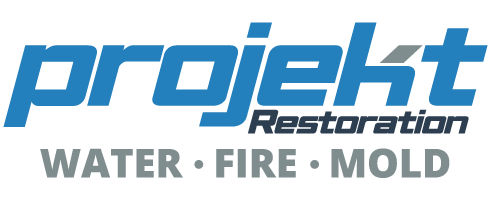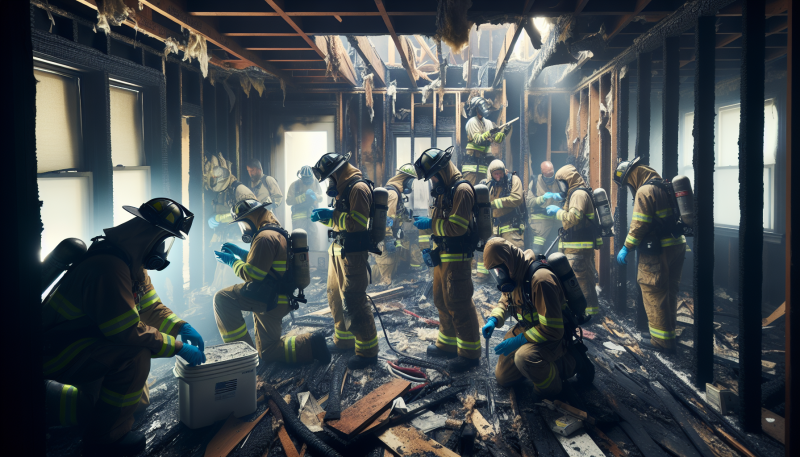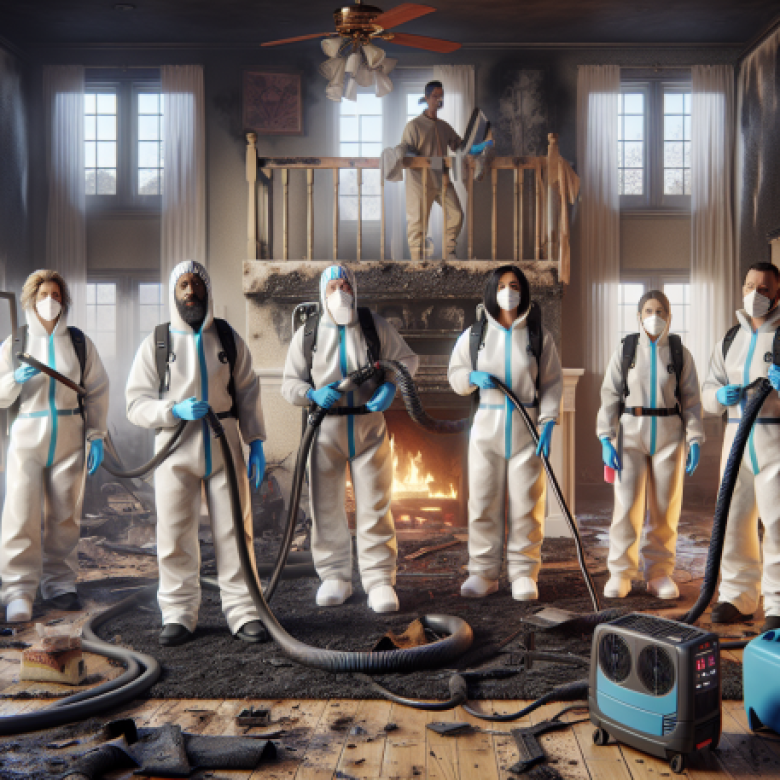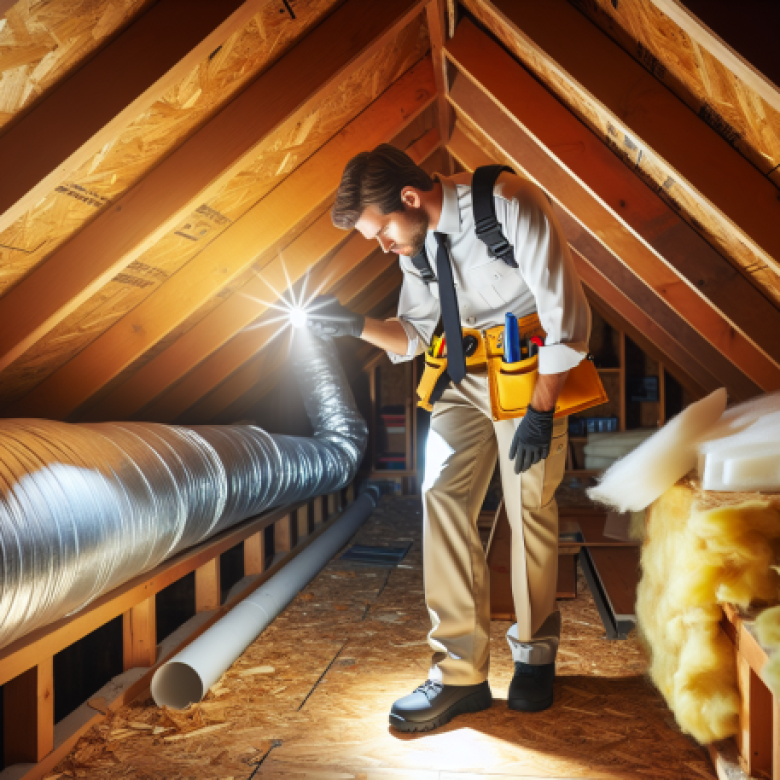Experiencing a fire in your home or business can be devastating, leaving behind extensive damage and uncertainty about the recovery process. Understanding the fire damage restoration timeline can help you prepare for what’s ahead and ensure a smooth restoration process. At Projekt Restoration, we specialize in fire damage restoration, helping property owners recover quickly and efficiently. Our team of experts provides comprehensive services, including smoke damage cleanup, water damage restoration, mold assessment, biohazard cleanup, and reconstruction. In this guide, we’ll walk you through the key stages of fire damage restoration, so you know what to expect at every step. Whether you’re dealing with minor smoke damage or extensive structural repairs, knowing the timeline can help you regain peace of mind and restore your property to its pre-loss condition.
Understanding the Fire Damage Restoration Process
The fire damage restoration process is a crucial step in recovering from a fire disaster. It involves multiple stages, each designed to ensure the safety of the property and restore it to its pre-loss condition. Understanding this process can help homeowners and business owners navigate the challenges that come with fire damage.
The first step in fire damage restoration is the initial assessment. Professionals assess the extent of the damage, identifying areas that require immediate attention. This includes evaluating structural integrity, smoke damage, and water damage from firefighting efforts. According to the National Fire Protection Association (NFPA), U.S. fire departments respond to an estimated 346,800 home structure fires per year, causing significant damage and requiring expert restoration services.
Once the assessment is complete, the next step is securing the property. This involves boarding up windows, doors, and other openings to prevent further damage from weather or vandalism. Additionally, tarping the roof may be necessary if it has been compromised.
After securing the property, the cleanup process begins. This includes removing debris, soot, and smoke residues. Smoke damage can be particularly challenging, as it can penetrate walls, furniture, and other porous materials. Professional restoration teams use specialized equipment such as air scrubbers and hydroxyl generators to eliminate smoke odors and improve air quality.
Water damage is another critical issue that must be addressed. Firefighting efforts often leave behind significant water damage, leading to mold growth if not properly handled. The drying process involves using industrial-grade dehumidifiers and air movers to remove excess moisture. If mold is detected, a mold assessment may be necessary to prevent further contamination.
Once the property is dry and free from smoke and soot, the restoration phase begins. This includes repairing structural damage, replacing drywall, repainting, and restoring flooring. In some cases, extensive reconstruction may be required to bring the property back to its original state. Professional restoration companies offer reconstruction services to ensure a seamless recovery process.
Content cleaning is another essential aspect of fire damage restoration. Many personal belongings, including furniture, clothing, and electronics, can be salvaged through specialized cleaning techniques. Ultrasonic cleaning, dry cleaning, and ozone treatment are commonly used methods to restore fire-damaged items. If the damage is extensive, professional content cleaning services can help recover valuable possessions.
Throughout the restoration process, professionals also focus on odor removal. Smoke odors can linger long after the fire is extinguished, making it necessary to use advanced deodorization techniques. Thermal fogging and ozone treatments are effective methods for eliminating persistent smoke smells.
The final step in fire damage restoration is a thorough inspection to ensure the property is safe and fully restored. This includes testing air quality, checking for hidden moisture, and ensuring all repairs meet safety standards. Homeowners and business owners can then return to their property with confidence, knowing it has been properly restored.
Fire damage restoration is a complex process that requires expertise and specialized equipment. Hiring a professional restoration company ensures that all aspects of the damage are addressed efficiently and effectively. According to the Insurance Information Institute, fire and lightning losses accounted for 23.8 percent of homeowners insurance claims in recent years, highlighting the importance of professional restoration services.
For those dealing with fire damage, understanding the restoration process can provide peace of mind and help streamline recovery efforts. By working with experienced professionals, property owners can restore their homes and businesses to their pre-fire condition as quickly as possible.
References:
- National Fire Protection Association. “Home Structure Fires.” Available at: https://www.nfpa.org/
- Insurance Information Institute. “Facts + Statistics: Homeowners and Renters Insurance.” Available at: https://www.iii.org/
Immediate Steps to Take After a Fire
Experiencing a fire in your home or business can be overwhelming, but taking immediate action is crucial to minimize further damage and begin the recovery process. The first step is ensuring the safety of everyone involved. Do not re-enter the property until authorities confirm it is safe. Once permitted, assess the extent of the damage and document everything with photos and videos for insurance purposes. Contact your insurance provider as soon as possible to initiate the claims process. Next, secure the property by boarding up windows and doors to prevent unauthorized access and further damage from weather conditions. Smoke, soot, and water used to extinguish the fire can cause additional harm, so professional fire damage restoration services should be contacted immediately. These experts will assess structural integrity, remove hazardous materials, and begin the cleanup process. Additionally, consider scheduling a thorough mold assessment, as lingering moisture can lead to mold growth. Salvaging personal belongings is another critical step. Items affected by smoke and soot may require specialized content cleaning to restore them to their original condition. Acting quickly can prevent further deterioration and increase the chances of recovery. Finally, begin planning for reconstruction and repairs to restore your property to its pre-fire condition. Working with a professional restoration company ensures a smooth and efficient recovery process, helping you return to normal life as soon as possible.
Assessing the Extent of Fire and Smoke Damage
After a fire, assessing the extent of fire and smoke damage is a critical first step in the restoration process. This evaluation helps determine the severity of structural damage, the level of smoke penetration, and the necessary steps for cleanup and repair. Fire damage can range from minor surface charring to extensive structural compromise, requiring a thorough inspection by professionals. Smoke damage, often underestimated, can seep into walls, ceilings, and HVAC systems, leaving behind harmful residues and persistent odors. Professionals use advanced techniques such as infrared thermal imaging to detect hidden damage that may not be visible to the naked eye. Additionally, soot and ash can cause corrosion and discoloration if not promptly addressed. The assessment process also includes evaluating the condition of personal belongings, determining which items can be salvaged through specialized content cleaning methods. In cases where structural integrity is compromised, reconstruction may be necessary to restore the property to its pre-loss condition. A comprehensive assessment ensures that all aspects of fire and smoke damage are identified, allowing for an effective and efficient restoration plan.
Securing the Property to Prevent Further Damage
After a fire, securing the property is a crucial step to prevent further damage and ensure safety. Fire-damaged structures are often left vulnerable to weather elements, vandalism, and potential structural collapses. The first priority is to assess the extent of the damage and take immediate action to stabilize the property. This includes boarding up broken windows, sealing openings, and reinforcing weakened structures to prevent additional deterioration. Additionally, tarping the roof is essential to protect the interior from rain and moisture, which can lead to further complications such as mold growth and water damage. Professional restoration teams use advanced techniques to secure the property efficiently, minimizing risks and preventing secondary damage. Beyond physical security, addressing environmental hazards is also necessary. Fire residues, smoke, and soot can pose health risks, making it essential to implement proper containment measures. Experts in fire damage restoration ensure that all hazardous materials are handled safely, reducing exposure to harmful contaminants. Another critical aspect of securing the property is assessing water damage caused by firefighting efforts. Excess water left behind can lead to structural weakening and mold growth if not addressed promptly. Utilizing specialized equipment such as infrared thermal imaging helps detect hidden moisture pockets, allowing for targeted drying and dehumidification. Additionally, professional restoration services provide comprehensive solutions, including reconstruction, to restore the property to its pre-loss condition. Taking swift action to secure the property not only prevents further damage but also accelerates the overall restoration process, ensuring a safe and efficient recovery.
Water Removal and Drying Process
After a fire, water damage is often a secondary issue due to the firefighting efforts used to extinguish the flames. The water removal and drying process is a crucial step in fire damage restoration, as standing water and excess moisture can lead to further structural damage and mold growth. The first step involves extracting standing water using industrial-grade pumps and vacuums. This process must be completed as quickly as possible to prevent water from seeping into walls, floors, and other porous materials. Once the bulk of the water is removed, specialized drying equipment such as air movers and dehumidifiers are strategically placed to accelerate the drying process. Moisture meters and infrared thermal imaging technology are often used to detect hidden moisture pockets that could lead to long-term damage if left untreated. Proper ventilation is also essential to ensure that damp areas dry thoroughly. In some cases, materials like drywall and insulation may need to be removed if they are too saturated to be salvaged. The drying process can take several days, depending on the extent of the water damage and the environmental conditions. Throughout this phase, professionals continuously monitor humidity levels to ensure that all moisture is effectively eliminated. If water damage is not addressed properly, it can lead to mold growth, which may require additional services such as mold removal to restore a safe and healthy environment. By following a thorough water removal and drying process, restoration experts help prevent further structural issues and ensure that the property is ready for the next phase of recovery.
Soot and Smoke Cleanup Techniques
After a fire, soot and smoke residues can cause extensive damage to walls, ceilings, furniture, and personal belongings. Proper cleanup techniques are essential to restore the affected areas and prevent long-term issues such as discoloration, corrosion, and persistent odors. The first step in soot and smoke cleanup is assessing the extent of the damage. Professionals use specialized equipment to determine the severity of contamination and develop a tailored cleaning plan. Dry soot, which is powdery and easier to remove, can often be cleaned with dry sponges or vacuuming, while wet soot, which is sticky and more challenging, requires chemical cleaning solutions. Smoke odor removal is another critical aspect of the cleanup process. Thermal fogging, ozone treatment, and air scrubbing are commonly used to eliminate lingering smoke smells from walls, carpets, and upholstery. Additionally, HVAC systems must be inspected and cleaned to prevent the circulation of soot particles throughout the property. In cases where structural elements are severely affected, reconstruction may be necessary to restore the integrity of the building. Professional fire damage restoration teams also focus on content cleaning, ensuring that salvageable items such as clothing, electronics, and furniture are properly treated and deodorized. The use of advanced techniques like infrared thermal imaging helps identify hidden soot deposits and moisture that could lead to secondary damage. Timely intervention is crucial in minimizing the impact of soot and smoke, as prolonged exposure can lead to permanent staining and deterioration of materials. Homeowners should avoid attempting DIY cleaning methods, as improper handling of soot can worsen the damage. Instead, relying on professional restoration services ensures a thorough and effective cleanup process, helping to restore the property to its pre-fire condition.
Structural Repairs and Reconstruction
Once the initial cleanup and mitigation efforts are complete, the next critical phase in fire damage restoration is structural repairs and reconstruction. This stage involves restoring the integrity of the building by repairing or replacing damaged walls, floors, ceilings, and other structural components. Fire can weaken a building’s foundation, compromise load-bearing walls, and cause extensive damage to electrical and plumbing systems. Professional restoration teams conduct thorough assessments to determine the extent of the damage and develop a comprehensive plan for rebuilding. Depending on the severity of the fire, reconstruction may involve minor repairs or complete rebuilding of certain sections of the property. Skilled contractors use high-quality materials to ensure the restored structure meets safety standards and building codes. Additionally, this phase includes addressing any lingering issues such as smoke damage, soot buildup, and water damage from firefighting efforts. Advanced techniques like infrared thermal imaging help detect hidden moisture and structural weaknesses that may not be visible to the naked eye. Homeowners and business owners should work closely with restoration experts to ensure the reconstruction process is efficient and thorough. This is also the stage where aesthetic elements such as flooring, drywall, and paint are restored to bring the property back to its pre-loss condition. If mold growth has developed due to water exposure, a proper mold assessment is necessary to prevent further complications. The goal of structural repairs and reconstruction is not only to restore the property’s functionality but also to ensure it is safe for occupancy. By working with experienced professionals, property owners can have peace of mind knowing their home or business is being rebuilt with precision and care. If you need expert assistance with fire damage recovery, do not hesitate to contact a trusted restoration company to guide you through the process.
Restoring Personal Belongings and Furniture
After a fire, restoring personal belongings and furniture is a crucial step in the recovery process. Many items may suffer from smoke, soot, and water damage, making professional cleaning and restoration essential. The process begins with a thorough assessment to determine which items can be salvaged and which need to be discarded. Specialized cleaning techniques, such as ultrasonic cleaning, dry cleaning, and ozone treatment, help remove smoke odors and soot residues from furniture, upholstery, and personal belongings. Wooden furniture may require refinishing, while upholstered items often need deep cleaning or reupholstering. Electronics and appliances exposed to smoke and soot should be inspected and cleaned to prevent long-term damage. Additionally, documents, photographs, and sentimental items can often be restored using advanced drying and cleaning methods. Engaging professional content cleaning services ensures that valuable possessions are treated with care and restored to their pre-loss condition whenever possible. Proper storage in a climate-controlled environment may also be necessary during the restoration process to prevent further deterioration. In cases where structural damage has affected furniture placement, reconstruction services may be required to restore the home’s interior before returning belongings to their rightful place. Homeowners should work closely with restoration professionals to prioritize salvageable items and ensure a smooth recovery process.
Addressing Air Quality and Odor Removal
After a fire, the lingering effects of smoke, soot, and airborne contaminants can significantly impact indoor air quality. Addressing these issues is a critical step in the fire damage restoration process to ensure a safe and habitable environment. Smoke particles can embed themselves in walls, ceilings, and HVAC systems, continuously releasing harmful pollutants into the air. Professional restoration teams use advanced air filtration systems, such as HEPA filters and air scrubbers, to remove fine particulate matter and improve overall air quality. Additionally, ozone treatments and thermal fogging are often employed to neutralize persistent smoke odors that can linger for weeks or even months. Proper dehumidification is also essential to prevent mold growth, which can thrive in the damp conditions left behind by firefighting efforts. Odor removal requires a multi-step approach, including deep cleaning of affected surfaces, upholstery, and ventilation systems. Specialized cleaning agents and techniques help break down smoke residues, ensuring that no unpleasant smells remain. In cases where fire damage is extensive, structural materials like drywall and insulation may need to be replaced to fully eliminate embedded odors. Homeowners should also consider professional consulting services to assess the extent of contamination and determine the most effective remediation strategies. Ensuring clean air after a fire is not just about comfort but also about health, as prolonged exposure to smoke-related pollutants can lead to respiratory issues and other health concerns. By taking proactive measures and working with experienced restoration professionals, homeowners can restore indoor air quality and create a safe living space for their families. If you need expert assistance in restoring your home after a fire, do not hesitate to contact a trusted restoration company for comprehensive solutions.
Working with Insurance for Fire Damage Claims
Navigating the insurance process after a fire can be overwhelming, but understanding how to work with your provider can make a significant difference in the outcome of your claim. The first step is to notify your insurance company immediately after the fire. Most policies require prompt reporting, and delaying this step could impact your ability to receive compensation. Once you have reported the damage, your insurer will assign an adjuster to assess the extent of the loss. It is crucial to document everything thoroughly, including taking photos and videos of the damage before any cleanup begins. Keeping a detailed inventory of damaged items will also help support your claim. Working with a professional fire damage restoration company can be beneficial, as they can provide detailed reports and estimates that align with insurance requirements. Additionally, understanding your policy’s coverage, including limitations and exclusions, will help you set realistic expectations for reimbursement. Some policies cover temporary housing costs if your home is uninhabitable, so be sure to ask your insurer about this benefit. If you encounter challenges during the claims process, consider seeking professional consulting services to ensure you receive a fair settlement. Once your claim is approved, the restoration process can begin, which may include structural repairs, smoke damage removal, and content cleaning to restore salvageable belongings. By staying organized, maintaining clear communication with your insurer, and working with experienced restoration professionals, you can streamline the claims process and restore your property efficiently.
Timeline for Each Stage of Fire Damage Restoration
Fire damage restoration is a multi-step process that requires careful planning and execution to ensure a property is fully restored. The timeline for each stage of fire damage restoration varies depending on the severity of the damage, the size of the property, and the extent of repairs needed. The process typically begins with an immediate response from professionals who assess the damage and take necessary steps to prevent further deterioration. Within the first 24 to 48 hours, emergency services such as board-up and tarping are performed to secure the property. Water extraction and dehumidification follow to remove excess moisture caused by firefighting efforts. The next phase involves a thorough inspection and damage assessment, which can take a few days to a week, depending on the complexity of the situation. During this time, professionals document the damage, create a restoration plan, and coordinate with insurance providers. The cleaning and soot removal process begins shortly after, typically lasting from a few days to a couple of weeks. This step includes deep cleaning of surfaces, air purification, and content cleaning to restore salvageable items. Structural repairs and reconstruction follow, which can take several weeks to months, depending on the extent of the damage. This phase includes repairing walls, ceilings, flooring, and other structural components to restore the property to its pre-fire condition. Throughout the process, continuous monitoring and inspections ensure that all restoration efforts meet safety and quality standards. The final stage involves a comprehensive walkthrough with the property owner to ensure satisfaction with the restoration work. While the timeline for fire damage restoration varies, working with experienced professionals ensures a smooth and efficient recovery process.
Common Challenges in Fire Damage Restoration
Fire damage restoration presents numerous challenges that can complicate the recovery process. One of the most significant issues is the extent of structural damage, which can compromise the integrity of a building. Fire weakens walls, floors, and ceilings, making it essential to conduct a thorough inspection before beginning any restoration work. Additionally, smoke and soot residues pose a major concern, as they can infiltrate porous materials, leaving behind stubborn stains and persistent odors. Proper content cleaning is necessary to salvage valuable belongings and prevent further deterioration. Another challenge is water damage resulting from firefighting efforts. Excess moisture can lead to mold growth, requiring immediate dehumidification to prevent secondary damage. Moreover, hazardous materials such as asbestos, lead, and chemical residues may be present, necessitating specialized handling and disposal. Coordinating with insurance providers can also be a complex process, as policy coverage varies, and documentation must be precise to ensure fair compensation. Additionally, the emotional toll on property owners cannot be overlooked, as losing personal belongings and facing displacement can be overwhelming. Effective communication and professional guidance are crucial in helping homeowners navigate the restoration process. Lastly, delays in obtaining permits and approvals for reconstruction can prolong the timeline, making it essential to work with experienced professionals who understand local regulations and can expedite the process. Addressing these challenges with expertise and efficiency ensures a smoother recovery and helps restore the property to its pre-loss condition.
Preventing Future Fire Hazards in Your Home
Preventing future fire hazards in your home is essential to ensuring the safety of your family and property. One of the most effective ways to minimize fire risks is by conducting regular inspections of electrical systems, appliances, and heating sources. Faulty wiring, overloaded circuits, and outdated electrical panels can be significant fire hazards, so it is crucial to have a professional assess your home’s electrical infrastructure. Additionally, keeping flammable materials such as paper, cloth, and chemicals away from heat sources can prevent accidental fires. Installing and maintaining smoke detectors in key areas like the kitchen, bedrooms, and hallways is another crucial step in fire prevention. These devices should be tested monthly, and batteries should be replaced at least once a year. Fire extinguishers should also be readily available in high-risk areas, and all household members should be trained on how to use them effectively. Proper storage of combustible materials, such as gasoline and propane, in well-ventilated areas away from direct sunlight can further reduce fire risks. Homeowners should also be mindful of potential fire hazards in the kitchen, as cooking-related incidents are one of the leading causes of house fires. Never leave cooking unattended, and always keep flammable items such as dish towels and paper towels away from open flames. Regularly cleaning grease buildup from stovetops and range hoods can also help prevent kitchen fires. In addition to these preventive measures, scheduling routine maintenance for heating systems, chimneys, and HVAC units can help identify and address potential fire hazards before they become serious threats. If your home has suffered fire damage in the past, working with a professional fire damage restoration team can help restore your property and implement preventive measures to avoid future incidents. Additionally, investing in fire-resistant building materials and furnishings can provide an extra layer of protection. If you are unsure about the fire safety of your home, consider scheduling a professional consulting service to assess potential risks and recommend necessary improvements. Taking these proactive steps can significantly reduce the likelihood of a fire and ensure a safer living environment for you and your loved ones.
Choosing the Right Fire Damage Restoration Company
Selecting the right fire damage restoration company is crucial to ensuring a smooth and efficient recovery process. After a fire, homeowners and business owners need a reliable and experienced team to restore their property to its pre-loss condition. The first step in choosing a restoration company is verifying their credentials, including certifications from industry organizations such as the Institute of Inspection, Cleaning and Restoration Certification (IICRC). A reputable company should also have extensive experience in handling fire damage, including smoke and soot removal, structural repairs, and content cleaning. Additionally, it is essential to check customer reviews and testimonials to gauge the quality of service and customer satisfaction. A professional restoration company should provide a detailed assessment of the damage and a clear timeline for the restoration process. They should also offer emergency services, as immediate action is necessary to prevent further damage. Transparency in pricing and communication is another critical factor to consider. Some companies provide a cost estimate using a calculator tool, which helps property owners understand the potential expenses involved. Furthermore, a reliable restoration company should coordinate with insurance providers to streamline the claims process. It is also beneficial to choose a company that offers additional services such as reconstruction to ensure a comprehensive restoration. By selecting a qualified and experienced fire damage restoration company, property owners can minimize stress and restore their homes or businesses efficiently.
FAQ: Fire Damage Restoration Timeline – What to Expect
If you’ve experienced a fire in your home or business, you likely have many questions about the restoration process. Below are some frequently asked questions (FAQs) to help you understand the fire damage restoration timeline and what to expect.
1. How long does fire damage restoration take?
The timeline for fire damage restoration varies depending on the extent of the damage. Minor fire damage may take a few days to a week, while severe damage requiring structural repairs can take several weeks or even months. The process includes assessment, cleaning, repairs, and final restoration.
2. What are the main steps in fire damage restoration?
The fire damage restoration process typically includes:
- Assessment & Inspection (within 24-48 hours) – Professionals evaluate the extent of the damage.
- Board-Up & Roof Tarping (immediate) – To prevent further damage from weather or vandalism.
- Water Removal & Drying (1-3 days) – If water was used to extinguish the fire, drying is necessary.
- Smoke & Soot Removal (several days) – Cleaning surfaces and air purification.
- Repairs & Reconstruction (weeks to months) – Restoring or rebuilding damaged areas.
3. Can I stay in my home during fire damage restoration?
It depends on the severity of the damage. If the fire caused structural damage, left behind hazardous smoke or soot, or disrupted essential utilities, it may not be safe to stay in your home. Your restoration company will advise you on whether temporary relocation is necessary.
4. How soon should I start the restoration process after a fire?
Restoration should begin as soon as possible—ideally within 24-48 hours—to prevent further damage from smoke, soot, and water. Delaying the process can lead to additional structural issues and health hazards.
5. Will my insurance cover fire damage restoration?
Most homeowners’ insurance policies cover fire damage restoration, but coverage details vary. Contact your insurance provider immediately after a fire to understand your policy and start the claims process. A professional restoration company can also assist with documentation for your claim.
6. What should I do immediately after a fire?
- Ensure everyone is safe and seek medical attention if needed.
- Contact emergency services and your insurance company.
- Avoid entering the property until it’s deemed safe.
- Hire a professional fire damage restoration company to assess and begin the cleanup process.
7. How do professionals remove smoke odor after a fire?
Restoration experts use specialized equipment such as air scrubbers, ozone generators, and thermal fogging to eliminate smoke odors. Deep cleaning of walls, ceilings, carpets, and HVAC systems is also necessary to remove lingering smells.
8. Can I clean up fire damage myself?
It’s not recommended. Fire damage involves hazardous materials like soot, smoke residue, and potentially toxic chemicals. Professional restoration teams have the expertise and equipment to safely and effectively clean and restore your property.
9. What happens if water damage occurs from firefighting efforts?
Water damage is common after a fire due to firefighting efforts. Restoration professionals will extract standing water, dry affected areas, and prevent mold growth as part of the restoration process.
10. How can I prevent future fire damage?
- Install and maintain smoke detectors.
- Keep fire extinguishers in key areas of your home.
- Avoid overloading electrical outlets.
- Practice fire safety measures, such as never leaving cooking unattended.
If you have more questions about fire damage restoration, consult a professional restoration company for personalized guidance. Acting quickly can help minimize damage and speed up the recovery process.
Would you like any modifications or additional details? 😊





